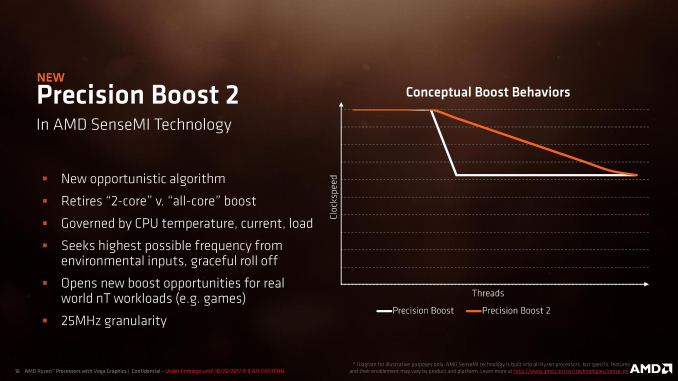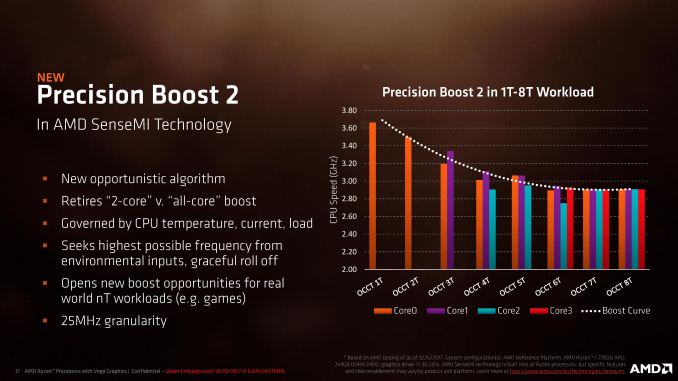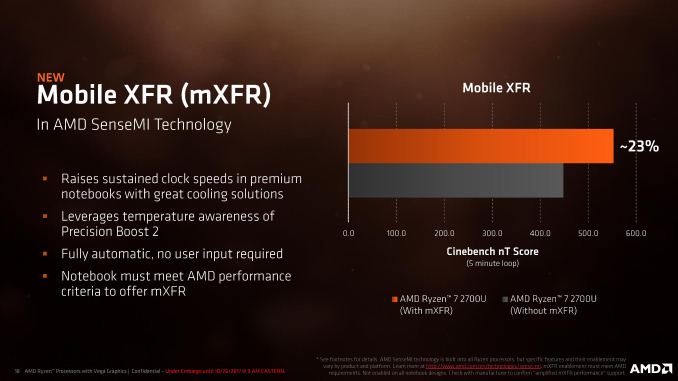Ryzen Mobile is Launched: AMD APUs for Laptops, with Vega and Updated Zen
by Ian Cutress on October 26, 2017 9:00 AM ESTSense Me Ryzen: Better Boost
When AMD launched the desktop Zen processors, it also branded a series of five technologies under the ‘SenseMI’ name. We covered these in detail in our Ryzen 7 review, but in short, it covers the following:
- Pure Power: Sensors to optimize power consumption
- Precision Boost: Determines how Turbo is applied
- Extreme Frequency Range: Going above maximum turbo when possible
- Neural Net Prediction: Using Neural Nets for prefetching data
- Smart Prefetch: Algorithms that work to enhance prefetch
With Ryzen Mobile, the features relating to frequency get an updated model, while Pure Power gets a bigger boost. We’ll cover the power changes on the next page, but it is worth talking about how AMD has improved Precision Boost and brought XFR to laptops.
Precision Boost 2
Most CPU turbo algorithms work by sensing how many cores and threads are under load, determining if the CPU has enough power headroom, and applying a voltage. This is why in the past both of the major x86 CPU manufacturers will quote a ‘per-core turbo frequency’ to show what the frequency should be when different numbers of cores are loaded and all else is fine (there is temperature/power headroom).
For Ryzen Mobile, AMD is pivoting to a new turbo model. When the system is in the P0 (top) turbo state, the system will use a new opportunistic turbo algorithm that rather than being based on the cores under load, is governed by CPU temperatures, currents, and how much load is being applied. The algorithm takes into account all the environmental inputs, such as skin temperature sensors and battery life, and will provide the best turbo frequency it can, regardless of if one thread is being used or all threads are being used.
It will be able to provide boost amounts at the 25 MHz granularity level, similar to how the desktop processors work, with the idea being that in most cases, if the system has a lot of cores available and a background process performs some very light work (such as checking for updates), rather than dropping 500-800 MHz because more cores are loaded, the system will keep at the high frequency.
AMD is stating that this has a big effect on real-world workloads, typically those that have variable thread workloads such as gaming.
When asked if Precision Boost 2 would be coming to the next generation of AMD’s Desktop Ryzen processors, I was told that ‘it could be inferred / it’s a safe bet’.
Mobile Extended Frequency Range (mXFR)
Because mobile systems are thermally limited, battery limited, power limited, and battery limited, offering ‘extra’ turbo headroom is not really something that processor manufacturers like to do. As a result, most of the Ryzen Mobile-powered notebooks will not have any form of XFR – AMD will be allowing it on a case-by-case basis for vendors that overengineer their chassis to be capable of supporting a higher power profile.
This feature essentially extends the average level at which Precision Boost 2 will operate, and also marks what could be considered a higher configurable TDP. One of the systems being launched with Ryzen Mobile this side of Christmas will be mXFR enabled, because the chassis is designed for 25W rather than 15W. It is worth noting that AMD states the configurable TDP of the Ryzen Mobile chips goes up to 25W, so this is likely the case what is happening.
Encode and Decode
AMD is fully using Vega’s encode and decode capabilities with Ryzen Mobile. The big inclusion for AMD’s mobile devices is the ability to decode VP9, the codec prefered in particular by YouTube.
| AMD Ryzen Mobile Encode/Decode Capabilities | |||||
| Decode 1080p @ 4:2:0 |
Decode 2160p @ 4:2:0 |
Encode 1080p |
Encode 1440p |
Encode 2160p |
|
| MPEG2 | 60 FPS | - | |||
| VC1 | 60 FPS | - | |||
| VP9 8/10 bpc | 240 FPS | 60 FPS | |||
| H.264 8 bpc | 240 FPS | 60 FPS | 120 FPS | 60 FPS | 30 FPS |
| H.264 10 bpc | 240 FPS | 60 FPS | |||
| HEVC 8bpc | 240 FPS | 60 FPS | 120 FPS | 60 FPS | 30 FPS |
| HEVC 10 bpc | 240 FPS | 60 FPS | |||
| JPEC 8bpc | 240 FPS | 60 FPS | |||













140 Comments
View All Comments
Alexvrb - Saturday, October 28, 2017 - link
No. XB1 has way more bandwidth than delta compression and other efficiency boosts can make up for. Dual channel DDR4 2400 vs quad channel DDR3 2133. That's even BEFORE you count a halfway talented developer's usage of the ESRAM, which when used properly takes a lot of pressure off the main memory. No, compute resources are the real limiting factor on XB1. The new XBOX on the other hand has plenty of both.nightyknight - Monday, October 30, 2017 - link
There is no way they will have the similar GPU performance lol.MonkeyPaw - Thursday, October 26, 2017 - link
Zen is more powerful than the Jaguar cores in the consoles, and even the 4C/8T Zen will beat out the 8C Jaguar, especially when boost is applied. That said, RR should be better than the original XboxOne (S), as that console has to make due with DDR3. The original PS4 uses GDDR5 and has a beefier GPU. I’d estimate it’s something like X1X > PS4pro > PS4 > RR > XboxOne/SThe qualifier here is that RR is limited to 25W, where some consoles go over 100W. I am pretty excited to see what sort of RR implementation awaits PS5 and Xbox(4).
Alexvrb - Thursday, October 26, 2017 - link
The DDR3 in XB1 isn't really a massive handicap like you're claiming, at least not in the hands of a halfway decent developer. First, it's quad-channel, not dual-channel like Raven Ridge. Second, there's a chunk of ESRAM that greatly boosts overall effective bandwidth. Bandwidth isn't the biggest limiting factor for the XB1. I suspect XB1 will still best even the 10 cluster Ryzen Mobile. However, for a 12-25W (15W nominal) design, RR is really impressive.MonkeyPaw - Thursday, October 26, 2017 - link
I forgot that XboxOne used 256bit memory. Still, I would suspect that RR still might beat it, at least if initial 1080P benchmark claims hold true. Many XboxOne titles didn’t render at 1080P, but more like 900P. If RR can do decent 1080P gaming even at medium, that’s pretty promising.Alexvrb - Saturday, October 28, 2017 - link
If you scale detail level to match, I highly suspect the framerate on XB1 will be higher. Match framerates and resolution and XB1 will have more detail. Don't get me wrong, again, I think RR will be entry-level game-capable which is more than I would say for any Intel chip that isn't paired with discrete graphics. But there will be compromises.Lolimaster - Saturday, October 28, 2017 - link
In cpu is probably way fast but in GPU it had like 2X less performance and probably more once you factor the lack of GDDR5 or HBM2 as dedicated ram.tipoo - Monday, October 30, 2017 - link
Or the MX150, which is popular in this segment.ddriver - Thursday, October 26, 2017 - link
That ideapad looked good until I saw "single channel"...Samus - Thursday, October 26, 2017 - link
Typical Lenovo fuckup right there. At least HP didn't commit their usual crime of cramming a 768p screen in a 15" laptop...